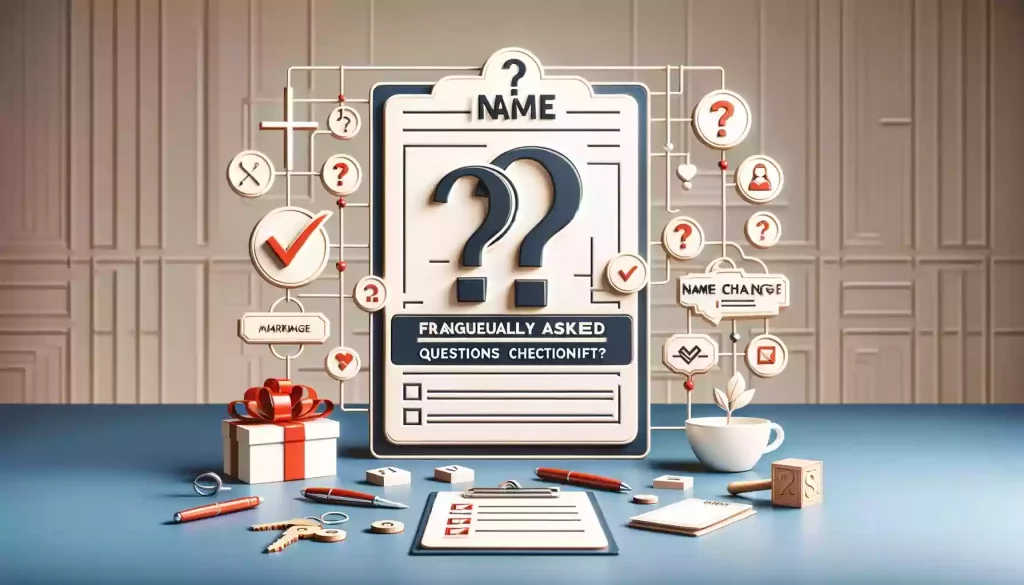Understanding the Process: What Does a Name Change After Marriage Involve?
Embarking on the journey of marriage often involves more than just a change in relationship status. For many, it also brings about the decision to change their name. Understanding what this process involves is crucial for a smooth transition. The act of changing your name after marriage is not just a ceremonial gesture but a legal one, involving several steps that require careful attention and planning.
The process involves various legal, professional, and personal considerations. From obtaining the necessary legal documents to updating your name across government agencies, financial institutions, and social circles, each step plays a pivotal role in solidifying your new identity. It's not just about signing a new name; it's about embracing a new part of your life and identity.
Despite being a common practice, many find themselves overwhelmed by the intricacies involved in a marriage name change. This guide aims to demystify the process, providing a comprehensive overview and practical steps to ensure your transition is as smooth and stress-free as possible.
Let's dive into the steps and considerations necessary to make your name change after marriage a seamless experience. Remember, while the process might seem daunting at first, with the right preparation and knowledge, it's a manageable and fulfilling journey.
Key Takeaways:
- A name change after marriage involves both legal and personal steps.
- It's important to gather all necessary documents and follow the correct legal procedures.
- Updating your name across various institutions and platforms is crucial.
- The process, though complex, is a significant part of embracing your new marital status.
- Proper planning and understanding can make the transition smoother and less overwhelming.
Step-by-Step Guide to Changing Your Name

Changing your name after marriage is a process that requires following specific steps to ensure legal compliance and smooth transition. This guide outlines a clear, step-by-step approach to help you navigate this significant change.
Step 1: Obtain Your Marriage Certificate - The first step in changing your name is to get a certified copy of your marriage certificate. This document serves as the legal foundation for your name change, required by most agencies and organizations.
Step 2: Update Your Social Security Card - Visit the Social Security Administration's website or local office to apply for a new card. This step is crucial as your social security number is tied to many other records.
Step 3: Get a New Driver's License or State ID - With your updated social security card, head to your local DMYou'll need to bring your current ID, marriage certificate, and potentially other documents, depending on your state's requirements.
Step 4: Update Your Passport - If you have a passport, you'll need to update it with your new name. This process involves filling out the appropriate forms, submitting your marriage certificate, and a new passport photo.
Step 5: Notify Employers and Professional Organizations - Inform your employer of your new name so they can update their records. This includes your payroll, email, and business cards. Also, update any professional licenses or memberships.
Step 6: Update Financial Accounts - Contact your bank, credit card companies, and any other financial institutions to update your name on accounts and cards. This step might require visiting in person with your marriage certificate and new ID.
By following these steps, you can ensure that your name change is recognized legally and reflected across all important documents and records. Remember, the order of these steps might vary slightly based on your specific circumstances and location.
Gathering the Necessary Documents
Before diving into the name change process, it's crucial to gather all necessary documents. Having these at hand will save time and reduce stress as you navigate through various steps.
1. Certified Copy of Your Marriage Certificate: This is the most important document. Ensure you have several certified copies, as many organizations require an original for processing.
2. Current Identification: Your current driver's license, passport, or state ID will be required to verify your identity when changing your name.
3. Social Security Card: You'll need your current social security card to apply for a new one. If you don't have it, you'll need to request a replacement first.
4. Birth Certificate: In some cases, you might need your birth certificate, especially when updating state or federal IDs.
5. Proof of Residence: Utility bills, lease agreements, or bank statements can serve as proof of residence if required by the DMV or other institutions.
6. Forms for Government Agencies: Many government agencies have specific forms for name changes. It's best to research and download these forms in advance.
7. Additional Legal Documents: If applicable, gather any court orders, divorce decrees, or other legal documents that might be relevant to your name change.
Organizing these documents before starting the process can significantly streamline your name change journey, ensuring you're prepared for each step along the way.
Notifying Government Agencies

Notifying various government agencies of your name change is a critical step in ensuring your new identity is recognized legally. This process can seem daunting, but with a clear understanding of where to start and what to expect, it becomes much more manageable.
1. Social Security Administration (SSA): The first government agency to notify is the SSA. A new social security card with your new name is essential for other legal changes. The process is free, and you can either mail in the application or visit a local SSA office.
2. Department of Motor Vehicles (DMV): Updating your driver's license or state ID is the next step. The DMV requires proof of your name change, usually your marriage certificate and new social security card. This step also involves a small fee.
3. U.S. Passport Office: If you have a passport, updating it is crucial. The process and fees vary depending on how long it's been since your passport was issued. You'll need to submit an application along with your marriage certificate and a new photo.
4. Internal Revenue Service (IRS): Notify the IRS of your name change to avoid any tax issues. This can be done by filling out a form or simply including a note when you file your next tax return.
5. Voter Registration: Update your voter registration to ensure you can vote without issues. This can often be done at the same time as updating your driver's license at the DM
6. Other Government Agencies: Depending on your situation, you may need to notify other agencies, such as the U.S. Postal Service, Veterans Affairs, or state tax agencies. Each agency has its own process for name change notifications.
Notifying these agencies in a timely and orderly manner will ensure that your legal identity is consistent across all government records, paving the way for a seamless transition to your new name.
Updating Legal and Financial Records
Changing your name on legal and financial documents is a significant aspect of the name change process. It's essential to tackle this task methodically to ensure all your records reflect your new name.
1. Bank Accounts and Credit Cards: Start by updating your name with your bank. This will involve visiting your local branch with your marriage certificate and new ID. Don't forget to request new checks and credit/debit cards.
2. Loans and Mortgages: Contact your lenders to update your name on any loans or mortgages. This step is crucial to maintain your credit history and avoid issues with property ownership.
3. Insurance Policies: Update your name on all insurance policies, including health, auto, life, and homeowners. This ensures coverage continuity and prevents potential claim issues.
4. Investment Accounts: If you have investment accounts, including retirement accounts, contact your financial advisor or the institutions directly to update your records.
5. Legal Documents: Revise any legal documents, such as wills, trusts, and power of attorney, to reflect your new name. This might require the assistance of a legal professional.
6. Property Titles and Registrations: If you own property or vehicles, ensure your name is updated on titles and registrations. This step might require additional documentation and fees.
By methodically updating these records, you help ensure that all aspects of your legal and financial life accurately reflect your new marital status and name.
Changing Your Name at Work and with Professional Associations
Once you've legally changed your name, it's important to update your professional identity. This process involves not just updating your name in your workplace but also with any professional associations you're a part of.
1. Notify Your Employer: Start by informing your employer of your name change. This includes updating your email, business cards, and nameplate, as well as informing human resources for payroll and legal purposes.
2. Update Professional Documents: Revise any professional documents, such as resumes, CVs, and portfolios, to reflect your new name. This is crucial for maintaining consistency in your professional image.
3. Professional Licenses and Certificates: If you hold any professional licenses or certificates, contact the issuing bodies to update your name. This step is essential to keep your qualifications valid.
4. Professional Associations and Networks: Inform any professional associations or networks you're part of about your name change. This ensures that your professional contacts and memberships remain current.
5. Email Signature and Voicemail: Update your email signature and voicemail message to reflect your new name. This small but important detail helps establish your new identity in your professional communications.
6. Networking Profiles: Update your name on professional networking sites like LinkedIn. This keeps your network informed and maintains the accuracy of your online professional presence.
7. Informing Colleagues and Clients: Consider sending a brief, professional note to colleagues and clients to inform them of your name change. This gesture can help avoid confusion and ensure smooth continued interactions.
By taking these steps, you can effectively transition your professional identity, aligning it with your new marital status and name.
Informing Friends, Family, and Colleagues
Informing your personal and professional circles about your name change is an important step in embracing your new identity. It's more than just a formal notification; it's a way to share a significant part of your life change.
1. Personal Announcement: Consider making a personal announcement, which can be as formal or informal as you like. This could be through a social media post, a mailed card, or an email.
2. Informing Family and Close Friends: Start with your immediate circle. Informing family and close friends personally can make them feel involved in this important change in your life.
3. Updating Social Media: Update your name on social media platforms. This is a quick way to inform a wider circle of acquaintances and distant relatives about your name change.
By informing those around you of your new name, you're inviting them to recognize and respect this significant aspect of your personal transformation.
Online Accounts and Digital Presence: What to Update
In today's digital age, updating your online presence and accounts is as important as changing your name on official documents. Your digital identity reflects your personal and professional persona, making it crucial to ensure consistency across all platforms.
1. Social Media Profiles: Update your name on all social media platforms you use. This includes Facebook, Instagram, Twitter, LinkedIn, and any others where your name appears publicly.
2. Email Accounts: Consider creating a new email address with your new name and gradually transitioning to it. Don't forget to update your name in the settings of your existing email accounts as well.
3. Online Subscriptions and Memberships: Update your name on any online subscriptions, memberships, forums, or communities you're part of. This helps maintain your online credibility and recognition.
4. Digital Profiles: Don't forget about your digital profiles on platforms like Amazon, Netflix, or other services where your name might be listed. Keeping these updated helps ensure a seamless online experience.
Updating these aspects of your digital presence not only reflects your new identity but also helps in maintaining a cohesive and professional online image.
Travel Considerations: Passports and Frequent Flyer Accounts
When it comes to travel, a name change requires careful attention to detail to ensure a smooth experience. Updating travel documents and accounts is a vital part of this process.
1. Updating Your Passport: If you have a passport, updating it should be a priority. The process can take several weeks, so plan accordingly, especially if you have upcoming travel plans.
2. Visas and Other Travel Documents: If you have visas or other travel documents, check the requirements for updating your name with the respective embassies or consulates.
3. Frequent Flyer and Loyalty Programs: Update your name with all airline frequent flyer programs and travel loyalty programs to ensure you continue earning and using points without issues.
4. TSA PreCheck and Global Entry: If you're enrolled in TSA PreCheck or Global Entry, update your name with these programs to avoid complications during airport security checks.
5. Travel Insurance: Ensure your travel insurance policies reflect your new name to avoid issues with claims or coverage while traveling.
6. International Travel Considerations: When traveling internationally, make sure all travel documents, including tickets and reservations, match the name on your passport.
By updating these travel-related documents and accounts, you can ensure a stress-free travel experience that reflects your new identity.
Marriage Name Change Checklist FAQ

Q1: How Long Does It Take to Change Your Name After Marriage?
A: The time frame varies depending on your location and the specific agencies involved. Generally, updating your social security card and driver's license can be completed within a few weeks, but passports and other documents may take longer.
Q2: Do I Need a Lawyer for a Marriage Name Change?
A: In most cases, a lawyer is not necessary for a marriage name change. The process is straightforward and can be completed with the appropriate forms and documents.
Q3: Can I Change My First Name During the Marriage Name Change Process?
A: Changing your first name is a different legal process and typically cannot be done through the marriage name change procedure. It usually requires a court order.
Q4: What Happens If I Don't Update All My Documents?
A: Failing to update all documents can lead to legal complications, identity confusion, and issues with financial accounts or travel. It's essential to update all relevant documents.
Q5: Should I Update My Name on Social Media and Online Accounts?
A: Yes, it's recommended to update your name on social media and online accounts to maintain consistency and avoid confusion in your personal and professional circles.
Common Pitfalls to Avoid in the Name Change Process
While changing your name after marriage is an exciting step, it's important to be aware of common pitfalls that can make the process more challenging than it needs to be.
1. Not Obtaining Enough Certified Copies of Your Marriage Certificate: Many agencies require original certified copies, not photocopies. Make sure to have several on hand.
2. Overlooking Smaller Accounts and Subscriptions: It's easy to remember big things like your driver's license and social security card, but smaller accounts and subscriptions are also important.
3. Not Updating Your Name Consistently Across All Documents: Ensure that your name is updated consistently across all legal and personal documents to avoid confusion and legal issues.
4. Underestimating the Time Required: The name change process can be time-consuming. Be prepared for it to take several weeks or even months.
5. Not Informing Employers and Professional Networks Promptly: Delaying the notification to your employer and professional networks can lead to misunderstandings and administrative complications.
By being aware of these common mistakes, you can navigate the name change process more effectively and avoid unnecessary stress.
Reflecting on the Emotional Aspect of a Name Change

A name change after marriage is not just a legal procedure; it's a deeply personal decision that can evoke a range of emotions. Understanding and acknowledging these feelings is an important part of the process.
1. Sense of Identity: Your name is a significant part of your identity. Changing it can bring about feelings of excitement, loss, or a new beginning. It's normal to experience a mix of emotions as you adjust to your new name.
2. Connection to Family and Heritage: For many, a name represents family history and heritage. Changing it may feel like losing a part of that connection, or it may feel like embracing a new family and future.
3. The Decision Process: Deciding whether to change your name can be challenging. It often involves deep reflection on your personal values, your relationship, and how you see yourself.
4. External Reactions: Reactions from family, friends, and colleagues can vary and may impact how you feel about your decision. It's important to stay true to what feels right for you.
5. Adaptation Period: Adjusting to your new name takes time. It might feel strange at first to hear and use it, but over time, it will start to feel more natural.
6. Personal Growth: Ultimately, a name change can be a powerful symbol of personal growth and the start of a new chapter in your life. Embrace this change as part of your unique journey.
Final Thoughts: Embracing Your New Identity
As you conclude the process of changing your name after marriage, it's a time to reflect and embrace your new identity. This final stage is about more than just completing a checklist; it's about stepping into a new phase of your life.
1. Celebrating the Change: Acknowledge the effort and time you've invested in this process. Celebrate this significant milestone in your life, perhaps with a small ceremony or gathering with close ones.
2. Integrating Your New Name: Start using your new name in all aspects of your life. As you integrate it, you'll begin to identify more with this new part of who you are.
3. Reflecting on the Process: Reflect on what you've learned about yourself during this process. Each step might have taught you something valuable about resilience, identity, or relationships.
4. Looking Forward: With your new name, you're opening a new chapter. Consider the goals, dreams, and adventures that await you and your partner in this next phase of your journey together.
5. Staying True to Yourself: Remember that a name change doesn't alter who you are at your core. Stay true to yourself and your values, even as you embrace this new identity.
6. Continuous Journey: Your journey of personal growth and identity doesn't end here. Continue to embrace life's changes and challenges with openness and enthusiasm.
Recommended Resources
- The Bride's Guide to Changing Her Name, Amy E. Goodman, Bantam, 2001
- Offbeat Bride: Creative Alternatives for Independent Brides, Ariel Meadow Stallings, Seal Press, 2010
- The Newlywed's Instruction Manual: A How-To Guide for the First Year of Marriage, Caroline Tiger, Quirk Books, 2009



.jpg.1626fbc48c04fd9021fd315819807524.thumb.jpg.882936eb5901fa05cf31c75617acde2e.jpg)
Recommended Comments
There are no comments to display.
Create an account or sign in to comment
You need to be a member in order to leave a comment
Create an account
Sign up for a new account in our community. It's easy!
Register a new accountSign in
Already have an account? Sign in here.
Sign In Now